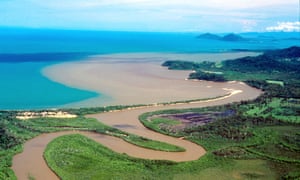Queensland government’s $7m purchase aims to cut back on sediment
flowing on to the reef, where it can smother coral and prevent its
recovery from bleaching


Environment groups are applauding a “fantastic move” by the Queensland government to protect the Great Barrier Reef by buying a Cape York cattle station responsible for a disproportionate amount of pollution that flows on to the reef.
The Queensland government has spent $7m buying the 560 sq km Springvale Station, situated south of Cooktown, the ABC reported on Wednesday.
Cattle stations cause erosion and long gullies that pour sediment into rivers that drain into the water around the Great Barrier Reef.
The Queensland environment minister, Steven Miles, said badly degraded grazing land on this one property was responsible for 40% of the sediment that flows from gully erosion into the Normanby river.
“Runoff from land carries sediment from the Normanby basin to the outer reef where it blocks light, smothers marine organisms and reduces coral and seagrass growth,” he said.
The Normanby river flows into the ocean near Lizard Island, where the Guardian revealed shocking images of coral bleaching and mortality this year.
In 2016, the Great Barrier Reef experienced its worst bleaching event in recorded history, with 93% of individual reefs affected and 22% of all the coral dying.
Poor water quality limits the ability of coral to cope with the rising temperatures that are causing the bleaching, and hampers its ability to recover after bleaching.
A recent report suggested that about $1bn needed to be spent every year for the next 10 years to adequately improve water quality on the reef.
“We need to make sure the reef has the best chance to recover from this event by making sure water flowing from the catchments is as clean as possible, and that includes stepping up effective erosion control measures on the gullies and rivers in far northern Queensland,” Miles said.
The Queensland government has spent $7m buying the 560 sq km Springvale Station, situated south of Cooktown, the ABC reported on Wednesday.
Cattle stations cause erosion and long gullies that pour sediment into rivers that drain into the water around the Great Barrier Reef.
The Queensland environment minister, Steven Miles, said badly degraded grazing land on this one property was responsible for 40% of the sediment that flows from gully erosion into the Normanby river.
“Runoff from land carries sediment from the Normanby basin to the outer reef where it blocks light, smothers marine organisms and reduces coral and seagrass growth,” he said.
The Normanby river flows into the ocean near Lizard Island, where the Guardian revealed shocking images of coral bleaching and mortality this year.
In 2016, the Great Barrier Reef experienced its worst bleaching event in recorded history, with 93% of individual reefs affected and 22% of all the coral dying.
Poor water quality limits the ability of coral to cope with the rising temperatures that are causing the bleaching, and hampers its ability to recover after bleaching.
A recent report suggested that about $1bn needed to be spent every year for the next 10 years to adequately improve water quality on the reef.
“We need to make sure the reef has the best chance to recover from this event by making sure water flowing from the catchments is as clean as possible, and that includes stepping up effective erosion control measures on the gullies and rivers in far northern Queensland,” Miles said.
By removing the grazing, it would lower the likelihood of new gullies forming. But he said to stop the existing gullies pouring sediment on the reef, intensive rehabilitation of the land was required.
Miles said the government was still investigating what to do with the land, but said in the short term it would be declared a nature reserve and managed by another group.
“The department is also exploring possible short- and long-term remediation measures to significantly reduce the amount of gully erosion,” he said.
Environmental groups applauded the move. “Never before has a government bought land to protect the water quality of the Great Barrier Reef,” said Nick Heath from WWF.
“Springvale is the biggest source of pollution in what is otherwise a pristine catchment.”
Imogen Zethoven from the Australian Marine Conservation Society said it was a “fantastic move”.
“It scores on a whole lot of fronts – water quality, biodiversity protection and into the Queensland national park estate. And it’s a legacy – it’s enduring. But obviously it will need a significant investment in rehabilitation of these huge gullies with massive erosion,” she said.
The charitable group South Endeavour Trust welcomed the move. “I think it’s a magnificent decision by the Queensland government to do something new, bold and really meaningful to protect the Great Barrier Reef,” said the South Endeavour Trust director, Tim Hughes.
Miles said the purchase was also critically needed for conservation.
“There are 48 mapped regional ecosystems on the property providing important habitat for the critically endangered bare-rumped sheathtail bat and other endangered or vulnerable flora and fauna species,” said Miles.
“These include the southern cassowary, northern quoll, spotted-tailed quoll, red goshawk, Semon’s leaf-nosed bat, ghost bat, spectacled flying-fox, greater large-eared horseshoe bat, Cooktown orchid and brown antelope orchid.
“This acquisition will also contribute to the state government’s commitment of increasing Queensland’s protected area estate towards 17%.”
No comments:
Post a Comment